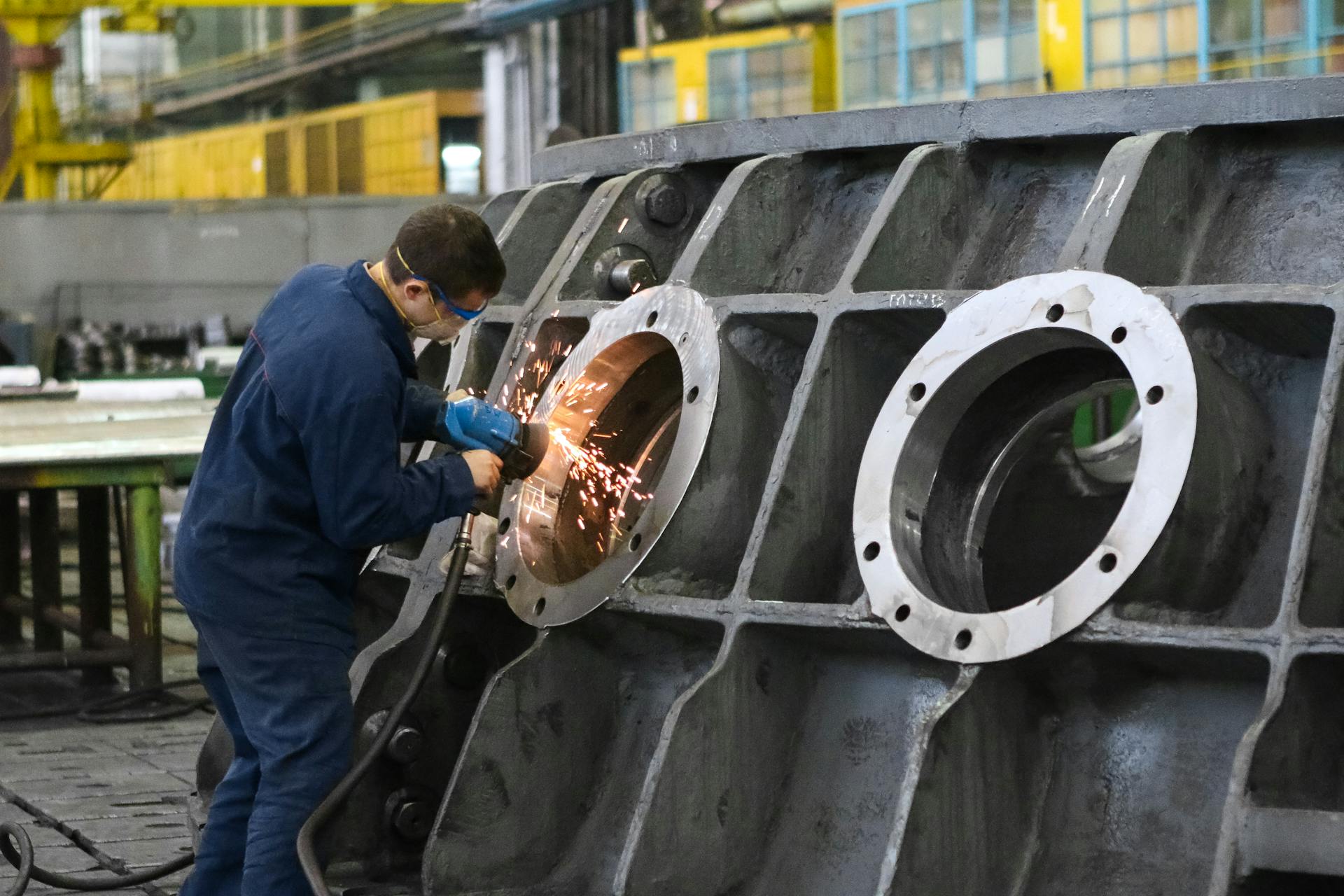Table of Contents
ToggleIntroduction
The pursuit of efficiency, safety, and cost-effectiveness in the dynamic realm of industrial operations prompts the use of novel approaches such as Predictive Maintenance with NDT. This methodology, especially when combined with Non-Destructive Testing (NDT), represents a major advancement in reducing downtime and increasing the life of vital equipment and infrastructure. Along with highlighting a proactive approach to maintenance plans, Predictive Maintenance using Nondestructive Testing (NDT) also exemplifies the smooth integration of established methods with state-of-the-art technologies, such as Data Analytics.
The increasing demand for Condition Monitoring and Equipment Health Assessment, which guarantee that machinery runs at maximum efficiency while preventing expensive downtime, is driving the shift to Predictive Maintenance. With the addition of Data Analytics, Predictive Maintenance surpasses traditional maintenance schedules by employing advanced Fault Detection Methods and real-time data to foresee potential issues. To offer a thorough understanding of the machinery’s current condition, prevent breakdowns, and optimize Asset Management Plans, this methodical technique employs Real-Time Data Analysis and Machine Learning in Nondestructive Testing (NDT).
Moreover, using NDT techniques like Ultrasonic Testing Applications within the context of Predictive Maintenance shows how technology may be used to improve and maintain the functionality and integrity of industrial assets. With the use of Predictive Analytics Tools, these technologies are opening up a new age in maintenance, wherein improvements in industrial safety and Maintenance Cost Reduction are real results rather than simply objectives.

As more and more sectors adopt these cutting-edge techniques, Data Analytics and Semantic Analysis play crucial roles in converting raw data into insights that can be put to use. This deliberate blending of technology and conventional maintenance methods portends an era in which industrial operations are predictively and proactively optimized for the problems of the future, rather than only being reactive.
The Paradigm Shift to Predictive Maintenance with NDT
An industry-wide paradigm shift towards machinery maintenance and system integrity is represented by Predictive Maintenance with NDT. This methodology uses Real-Time Data and Advanced Analytics to predict probable failures before they happen, going beyond typical reactive and scheduled maintenance strategies. This change significantly improves the efficacy, safety, and cost-effectiveness of industrial processes and optimizes maintenance duties.
Machine Learning, Data Analytics, and Non-Destructive Testing (NDT) are just a few of the technologies used in Predictive Maintenance to trace the condition of equipment over time. This method minimizes unnecessary maintenance by scheduling interventions at the most advantageous times, helping to prevent expensive downtime brought on by unplanned equipment failures.
Key Points:
- Extended Equipment Life: Regular maintenance and monitoring based on the real state of the machinery can greatly increase its useful life.
- Cost Efficiency: By anticipating maintenance needs, businesses may minimize the impact of maintenance on output and prevent the higher costs of emergency repairs.
- Enhanced Safety: Early identification of potential failures reduces the risk of accidents and equipment malfunctions, improving worker and operational safety.
- Reduced Downtime: Predictive Maintenance schedule interventions based on insights from Data Analytics, which significantly lowers unplanned downtime.
- Better Resource Allocation is possible by more effectively scheduling operations and only deploying maintenance staff when required.
Data-driven decision-making is a strong basis for deliberating on maintenance schedules and other operational matters are provided by the integration of Data Analytics and Machine Learning with NDT insights.
The Role of Predictive Maintenance with NDT
A key element of the Predictive Maintenance context, Non-Destructive Testing (NDT) expands the consistency and value of maintenance methods in a variety of sectors. NDT methods offer thorough equipment and infrastructure inspection without compromising current operations or causing harm.
Here’s a detailed look at how NDT contributes to Predictive Maintenance:
- Early Issue Identification: Nondestructive Testing (NDT) techniques like magnetic particle inspection, radiography, and ultrasonic testing can find material faults and weaknesses long before they become serious issues. Strategies for preventative maintenance depend on these early detection capabilities.
- Data Gathering and Analysis: Nondestructive Testing, or NDT, collects a wealth of information on the condition of machines. Methods such as vibration analysis, thermography, and acoustic emission can offer a thorough picture of the operational health of machinery. This data is required by Predictive Analytics to foresee future issues and recommend maintenance steps.
- Safety Enhancements: NDT helps guarantee the safety of the equipment and its people by spotting any safety issues before they cause failures. Workplace safety is improved overall and this proactive maintenance strategy considerably decreases accident risk.
- Reducing Downtime: Predictive Maintenance solutions that incorporate Non-Destructive Testing (NDT) enable the scheduling of repair during planned downtime, as opposed to reactive maintenance responses to unforeseen failures. The operational disruptions and related downtime expenses are reduced with the use of this planned method.
- Durability of Equipment: By ensuring that little problems are fixed before they become serious malfunctions, routine use of NDT techniques can help machinery last longer. This maximizes industrial asset returns on investment while also reducing replacement costs.
- Improved Maintenance Scheduling: Rather than depending on a preset plan, maintenance can be more precisely scheduled based on the actual state of the equipment thanks to the exact information supplied by NDT. Enhancing the efficiency of resource usage is guaranteed by optimizing maintenance tasks.
A potent synergy that increases the advantages of both techniques is created when NDT and Predictive Maintenance are combined. This ultimately leads to more dependable, economical, and efficient industrial operations by enabling a more advanced, Data-Driven approach to maintenance that is in line with current technology breakthroughs.

Advantages of Integrating Predictive Maintenance with NDT
1. Optimised Safety and Dependability:
Machine flaws or weaknesses can be found early on and catastrophic failures prevented by using advanced nondestructive testing (NDT) techniques including radiographic inspection and ultrasonic testing. By reducing the likelihood of accidents, preventive maintenance of machinery before significant breakdowns occur significantly improves operational reliability and raises workplace safety. Because even a little flaw that goes undiscovered can have catastrophic consequences in industries like aerospace, nondestructive testing (NDT) is crucial for routine inspections.
2. Cost-Effective Operations:
Organizations can stay away from the hefty expenses linked to unscheduled downtime and emergency repairs by using NDT techniques to detect problems before they worsen. Little repairs rather than pricey replacements are made possible by predictive maintenance models that use NDT data and assist in identifying any issues in their early stages. This methodology not only minimizes immediate repair expenses but also diminishes the frequency of expensive operational disruptions that impact the ultimate return on investment.
Predictive maintenance, bolstered by NDT insights, enables the scheduling of repairs during off-peak hours or at a time when it least interferes with production plans, leading to optimized maintenance schedules and increased operational efficiency. This planning avoids the unnecessary expenses and inefficiencies of routine scheduled maintenance regardless of actual necessity by using real-time data about the status of the equipment to ensure that maintenance is only done when necessary.
3. Longer Usable Life of Equipment:
The usable life of the equipment is prolonged by precise, routine maintenance that is guided by NDT results. Early problem-solving reduces wear and tear on components and extends the equipment’s useful life, improving return on investment. Because less trash and fresh resources are required, this strategy also advances sustainability.
4. Decisions Driven by Data:
Including NDT data in predictive maintenance models helps to better anticipate future maintenance requirements and makes making well-informed decisions easier. Instead of depending just on less precise generic schedules, this use of Data Analytics can help customize maintenance methods that are specially matched to the actual characteristics of the equipment. It also enables a more thorough understanding of how the equipment behaves under different operating conditions.
Implementation Challenges and Solutions
While Predictive Maintenance with NDT recommends numerous benefits, it also poses certain challenges, especially when used in conjunction with Non-Destructive Testing (NDT). These challenges may vary depending on the sector, the kind of machinery being utilized, and the existing maintenance protocols. But to fully enjoy the benefits of Predictive Maintenance with NDT, these problems must be recognized, and workable solutions must be developed.
An outline of typical implementation issues and possible fixes is provided below:
Challenges of Predictive Maintenance with NDT
1. High Initial Costs:
The expense of sophisticated NDT equipment, sensors, data storage options, and analytics software can make the setup of Predictive Maintenance systems costly. Often, integrating these technologies necessitates a large upfront expenditure.
2. Complexity of Data Management:
It might be intimidating to manage the massive amounts of data produced by ongoing monitoring. Effective data collection, archiving, processing, and analysis necessitate complex data management methods and knowledge.
3. Talent Gap:
When it comes to the application of sophisticated NDT methods and Data Analytics, there is frequently a talent gap in the workforce. To accurately interpret NDT data and effectively use new Predictive Maintenance technology, employees might need training.
4. Integration with Current Systems:
It can be difficult to integrate new Predictive Maintenance with NDT technology with current workflows and maintenance management systems. For data to flow correctly and maintenance plans to be optimized without interfering with ongoing operations, this integration must be flawless.
5. Cultural Resistance:
An organization’s culture must change to transition from traditional maintenance methods to Predictive Maintenance with NDT techniques. Since this change affects long-standing job positions and workflows, there may occasionally be pushback from inside the organization.

Potential Solutions of Predictive Maintenance with NDT
1. Staged Deployment:
Businesses can choose to take a staged approach to deployment to control expenses and reduce risk. One way to control expenses and show early benefits is to start with essential assets and progressively expand the system.
2. Investing in Training and Development:
It’s critical to close the skill gap by implementing extensive training initiatives. The technical parts of Predictive Maintenance with NDT (Nondestructive Testing) should be covered in training, along with data interpretation and decision-making.
3. Sophisticated Data Analytics Tools:
Handling massive data sets can be made easier by utilizing machine learning and sophisticated Data Analytics techniques. Many of the steps required in data analysis can be automated with the help of these tools, increasing system efficiency and reducing reliance on human interpretation.
4. Integration Professionals:
Ensuring that new systems are seamlessly linked with the current IT infrastructure can be achieved by hiring or consulting with integration professionals. By doing so, the changeover can go more smoothly and support continued operations.
5. Change Management:
Cultural resistance can be addressed through effective change management techniques. These may involve incorporating employees in the process of creating and executing the plan, outlining the advantages of Predictive Maintenance in detail, and acknowledging and acting upon employee concerns and recommendations.
Organizations can successfully adopt Predictive Maintenance systems that increase equipment longevity, lower costs, and improve operational efficiency by tackling these issues with well-considered solutions. This tactical strategy optimizes the advantages of combining Predictive Maintenance with NDT while minimizing implementation-related hazards.
Future Directions of Predictive Maintenance with NDT
With technology continuing to evolve and improve its capabilities, the future of Predictive Maintenance with NDT appears bright. Industries are about to undergo a radical change in the way they handle equipment maintenance with the integration of Data Analytics, machine learning, and increasingly advanced Non-Destructive Testing (NDT) techniques like phased array ultrasonics and digital radiography.
The capacity to forecast failures with high accuracy and little human involvement will improve dramatically as sensors become more affordable and AI more potent. With even more exact maintenance schedules made possible by this progression, equipment lifespan will be increased and downtime and maintenance expenses will be further minimized.
Furthermore, an increasingly automated and networked approach to maintenance management will be made possible by the confluence of NDT and Predictive Maintenance with emerging technologies like big data platforms and the Internet of Things (IoT). Predictive Maintenance with NDT plans can be made more dynamic and responsive by utilizing real-time data from a network of linked devices.
To ensure maximum efficiency and dependability in industrial operations, this Data-Driven strategy will enable organizations to predict and adjust to changes in equipment performance and operational demands in addition to reacting to possible problems. With deeper insights and the ability to drive more proactive, intelligent maintenance decisions, Data Analytics will play a bigger and more important role in Predictive Maintenance as industries continue to change.

Conclusion
Combining the accuracy of Non-Destructive Testing (NDT) with the foresight of Predictive Maintenance techniques, Predictive Maintenance with NDT is a major advancement in industrial operations that will pave the way for a time when equipment failures are not only managed but also accurately predicted. This method maximizes the financial effectiveness of maintenance procedures while simultaneously improving operational safety and dependability through the integration of Data Analytics and cutting-edge technologies like machine learning and the Internet of Things.
The combination of Predictive Maintenance with NDT allows for a fundamental change in maintenance, moving from a reactive to a proactive methodology. By detecting possible problems before they become expensive breakdowns, industries may save downtime, cut maintenance expenses, and increase the operational life of vital equipment. A Data-Driven framework that enables organizations to make strategic decisions in line with both short-term operational demands and long-term goals supports this progression.
The application of Data Analytics to Predictive Maintenance will grow as technology develops, opening the door to increasingly complex, automated, and networked maintenance systems. These advancements hold the potential to both redefine the standards for industrial efficiency and dependability as well as improve the effectiveness of present maintenance practices.
To fully reap the benefits of Predictive Maintenance with NDT, organizations must overcome obstacles including difficult integrations and cultural shifts. But with a dedicated focus on education, wise financial decisions, and a willingness to adapt, industrial maintenance appears to have a bright and even revolutionary future. The combination of these approaches is expected to have a significant impact on the industrial operations environment as industries continue to develop. This highlights the crucial importance of adaptability and forward-thinking in achieving operational excellence.


